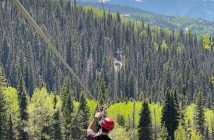The Zip-Flyer ZF Track Braking System itself has been installed on the busiest zip line in the world, in Las Vegas, as well as at many ski resorts, including Vail Resorts’ properties in Vail and Breckenridge, Colorado.
Since that system is overkill for the broader mid-commercial market, Zip-Flyer introduced the Zip-Trolley system. “The Zip-Trolley System is the boiled down version of our ZF Track Braking System, designed specifically for the masses, offering the same benefits of triple redundancy, smaller towers and pin-point landing,” Lerner says.
For those operators and venues looking for a simpler, less expensive, and nimbler option, particularly in the adventure park world, the Aerial Braking System (ABS) from Aerial Designs is a traditional passive brake block controlled zip line braking system—but with a specially designed catch mechanism that enables guides to pull guests that would otherwise not make it all the way to the arrival platform.
Retrievals are a major problem for zip line tours, as they cut down on guest enjoyment and tour profitability. Retrievals take time, so operators must plan for longer tours and consequently cannot operate at full capacity. The ABS essentially reduces retrievals to zero, increasing guest throughput, says Aerial Designs owner Valdo Lallemand. It also increases guide confidence and works well for tight stopping areas, such as in forests and on towers.
Lallemand, an engineer from France who is now based in Seattle, Wash., developed the ABS from his experience of building dozens of zip lines over the last decade. “We saw about five years ago the need for a system that would reduce retrievals,” he says. “We designed this system with a Canadian engineer, Harold Engineering, and it is a very simple, robust system. It is a fraction of the cost compared to the magnetic braking systems.”
That’s why several other builders buy the system as OEMs, he adds, saying, “What I’m hearing from them is they like the system because it’s affordable, simple, and effective.”
DYNAMICALLY CONTROLLED BRAKING
Last but not least, zip line innovator ZipRider approaches braking from an entirely different angle. Its ZipTour rider-controlled system, invented by Eric Cylvick, of Terra Nova LLC and Zip Install LLC of Park City, Utah, is a combination of active and passive braking.
ZipRider zip lines are designed so there is no sag in the line. Riders pull the brake off when they start their ride, and can apply braking to control their speed or even stop mid-span. If riders release their grip on the brake, the trolley comes to a stop.
“As far as I’m concerned, the dynamically controlled trolley brake that we have is one of the most interesting aspects of any zip line product. You can go 70 or you can go five miles per hour. In my opinion, the days are numbered for long, multi-span zip line products that are just three, four, five percent grade products that you control with a glove. I’m not talking about tomorrow, but over the next five years that’s the direction the industry is going to go. Being able to control your own speed, like in anything—skiing, mountain sleds, mountain biking—the days of just clipping on and going, people are going to find tiresome to a certain extent.
“Having the riders control their own speed creates a much more exciting zip line ride, and also creates a shared mountain experience that is quite similar to skiing. The riders are just seeing the mountain from a different point of view.
“We are planning to introduce a new product, very much related to the ZipTour, in the spring of 2016 that will take this rider-controlled concept to an entirely new level,” Cylvick adds.
And that seems to sum up the zip line business: the basic thrills remain the same, but the technology is constantly on the move.






